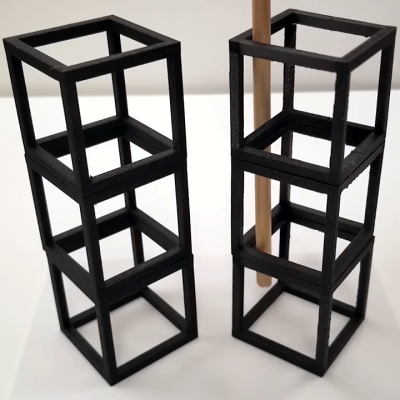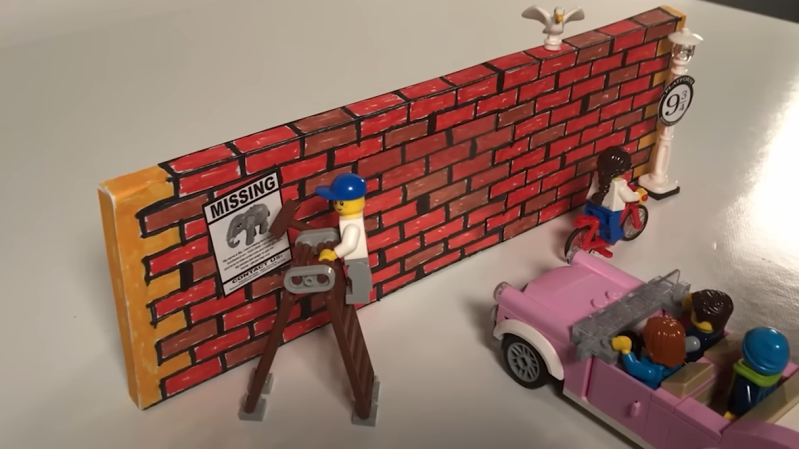Illusions are perceptual experiences that do not match physical reality, and the 2023 Illusion of the Year contest produced a variety of nifty ones that are worth checking out. A video for each is embedded below the break, but we’ll briefly explain each as well.
 Some of the visual illusions play with perspective. One such example happens to be the contest winner: Platform 9 3/4 has a LEGO car appear to drive directly through a wall. It happens so quickly it’s difficult to say what happened at all!
Some of the visual illusions play with perspective. One such example happens to be the contest winner: Platform 9 3/4 has a LEGO car appear to drive directly through a wall. It happens so quickly it’s difficult to say what happened at all!
Another good one is the Tower of Cubes, which appears as two stacks of normal-looking hollow cubes, but some of the cubes are in fact truly bizarre shapes when seen from the side. This is a bit reminiscent of the ambiguous cylinder illusion by Japanese mathematician and artist [Kokichi Sugihara].
Cornelia is representative of the hollow face illusion, in which a concave face is perceived as a normal convex one. (Interestingly this illusion is used to help diagnose schizophrenia, as sufferers overwhelmingly fail to perceive the illusion.)
The Accelerando Illusion is similar to (but differs from) an auditory effect known as the Risset Rhythm by composer Jean-Claude Risset. It exploits ambiguities in sound to create a dense musical arrangement that sounds as though it is constantly increasing in tempo.
The Buddha’s Ear Illusion creates the illusion of feeling as though one’s earlobe is being stretched out to an absurd length, and brings to mind the broader concept of body transfer illusion.
While it didn’t appear into the contest, we just can’t resist bringing up the Thermal Grill Illusion, in which one perceives a painful burning sensation from touching a set of alternating hot and cold elements. Even though the temperatures of the individual elements are actually quite mild, the temperature differential plays strange tricks on perception.
A video of each of the contest’s entries is embedded below, and they all explain exactly what’s going on for each one, so take a few minutes and give them a watch. Do you have a favorite illusion of your own? Share it in the comments!
[via IFLScience]
















My favourite illusion is the checker shadow illusion.
https://en.m.wikipedia.org/wiki/Checker_shadow_illusion
We think our vision is what our retinas detect, but our retinas would know the chess squares are the same shade.
It’s actually our brain’s interpretation of what we see that forms our vision. And in this case our brain is trying to be clever because it knows the shadow that’s cast means it has to adjust the retina-sensed brightness value to account for the shadow in order to estimate the actual material’s brightness. So our vision (which comes from the brain, not the eye) presents them as different shades, even though the retina would be seeing identical values.
We don’t see pixels like a camera. We see stories about the world around us. That’s very cool.
“We don’t see pixels like a camera.”
Right, we see the scene like a highly-compressed MPEG, upscaled by some OpenDream AI processing.
The human Mark I eyeball has roughly a million image sensors. There is some processing done at the retina to optimize edge & motion detection, to stuff the most important relevant information down the skinny data pipe to the brain. “Relevant information” decided by natural selection, of course. They who perceive a predator or food sooner survive.
There are about a million nerves transferring scene data from the eyeball to the brain, and each can transfer only a few bits per second of information: The actual data rate from an eyeball is only a few Mbits/second.
Most of what we perceive in a scene is interpolated or invented by the visual processing system in the brain.
Our notion of making camera images with pixels is really quite quaint and naive. They may be “Objective Truth” (for some definitions of “objective” and “truth”), but our current scene-capturing devices still lack interpretation. They brute-force acquire and transmit gross amounts of raw data, for relatively little actual information. Back-end processing systems then inhale that firehose of data, to process and produce desired information (“road sign”, “pedestrian”, “good part”, “bad part”).
That brute-force cave-man approach to scene processing is computation- and energy-intensive. The human eyeball and brain system does all that work on only a few watts of power, despite the woefully inefficient meat-based processor.
We’ll see power-frugal dedicated scene-interpretation devices soon enough. Some already exist, like for gesture recognition. There will be more, and for applications you haven’t thought of yet. Gait and facial recognition are just the thin edge.
I’ve never understood it being called the Mark I eyeball. Do people really think there were no previous versions of the eye? Or do they just not believe in evolution?
It’s a joke, son. Good enough for Chuck Yeager, good enough for me.
Now I can add the Accelerando Illusion to the Shepard Effect (the beginning of Queens’ A Day At The Races).
The one thing which is slightly disappointing is that the listed optical illusions really only work either as video or with one eye closed (or obstructed, perhaps with a single-eye peephole). Depth perception from two eyes would ruin the effect, particularly ones like “Platform 9 3/4” and “Tower of Cubes” or even the famous “Ames Room” would “fall apart” as the two images combine in our mind to show us that the object is radically different from any 2d/flat representation.
The “hollow face” or ” hollow dragon” illusion would work best of these in person, until you got too close, or from too much of an angle from straight-on, so i believe these are the best for an in-person effect. Although really only in the horizontal axis, mostly because the hollow face distorts the opposite way to the expected way a real face would when looked at from angles above or below.
A good “Ames Room” is closer to “hollow face” then you give it credit for imo
(in terms of fooling the brain i mean, our depth perception “doesnt reach very far”)